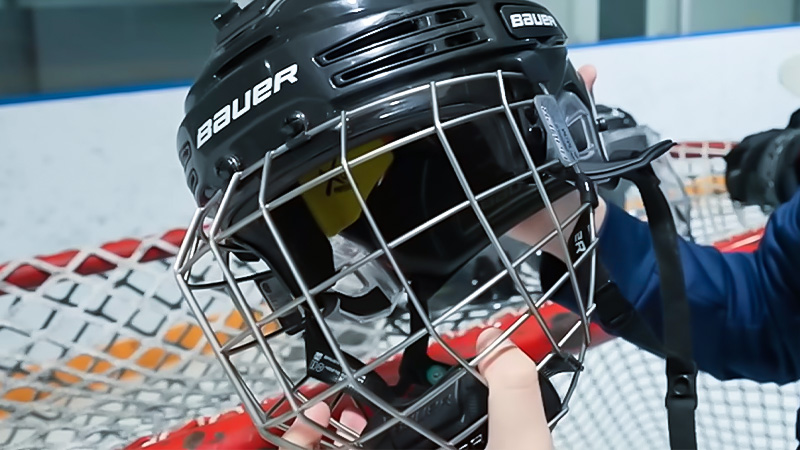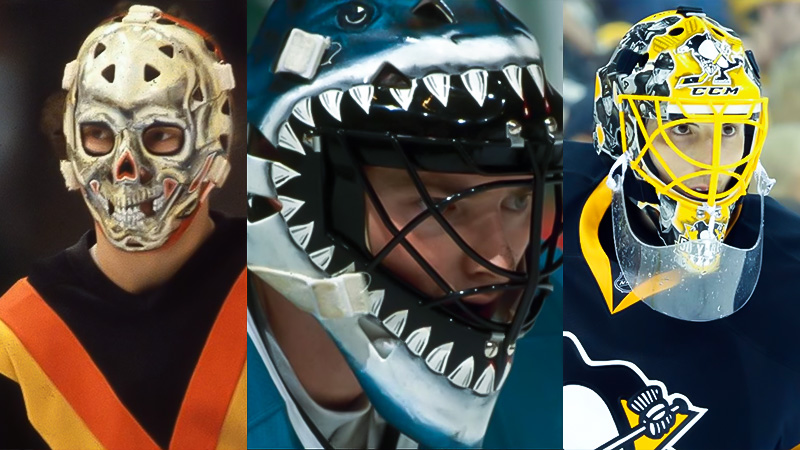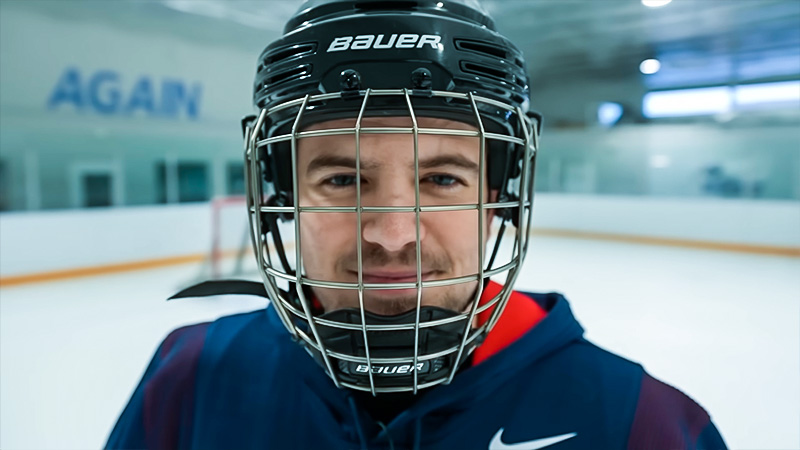High-impact world of professional ice hockey, safety is paramount. Yet, if you’ve ever tuned into an NHL game, you may have wondered why don’t NHL players wear cages for protection. The absence of cages is a distinct feature of the NHL, reflecting a unique blend of tradition and player preference.
In this blog post, we delve into the reasons behind this choice, exploring the historical evolution of facial protection in hockey and the advantages and disadvantages of wearing cages in the NHL.
From the earliest days of the sport to the modern era, facial protection has undergone significant changes, and why today’s NHL players opt for visors and shields over cages requires a closer look. So, let’s uncover the intricacies behind this intriguing aspect of the world’s fastest sport. So, stay focused.

Can You Wear Cages in NHL?
No, NHL players cannot wear cages during regular-season games. The NHL mandates that players wear full face shields or visors, but cages are not permitted. However, there are certain exceptions.
Players who entered the NHL before the 2013-2014 season were allowed to continue wearing a visor or shield if they signed a waiver indicating their preference.
Additionally, during practices and non-game situations, players are free to wear cages or full face protection if they choose to do so for safety reasons. Nevertheless, during official games, cages are not an option as they could obstruct vision and are not in compliance with league regulations.
Why Don’t NHL Players Wear Cages?
NHL players don’t wear cages during regular-season games primarily for reasons related to tradition, comfort, and performance. Here are some key factors:
Tradition
The NHL has a long history of players not wearing full cages. This tradition dates back to the early days of professional hockey when players did not have the same level of protective equipment. The culture of the sport has evolved to prioritize toughness and visibility, which cages can limit.
Visibility
Cages can obstruct a player’s vision, especially in their peripheral vision, which is crucial in fast-paced games like hockey. Visors and shields provide a higher level of visibility and allow players to see the puck, opponents, and teammates more clearly.
Comfort and Performance
Many players find visors or shields more comfortable to wear during games. They allow for better airflow, which can reduce fogging and overheating. Players also claim that they feel less restricted with visors, which can impact their performance on the ice.
Transition Period
The NHL implemented mandatory visors for incoming players starting in the 2013-2014 season. However, players who were already in the league before that date were allowed to continue playing without visors if they signed a waiver, which some of them chose to do due to personal preference.
While safety is a priority in the NHL, players have historically preferred visors and shields for the benefits they offer in terms of visibility, comfort, and performance, despite the increased risk of facial injuries compared to cages.
The Evolution of Hockey Facial Protection

The evolution of facial protection in hockey has been a response to the sport’s growing emphasis on safety and player welfare. Here’s a brief overview of how facial protection has evolved over the years:
Early Days (Late 1800s – Early 1900s)
- In the early days of hockey, players wore little to no facial protection.
- Some players used leather or cloth face coverings for minimal protection.
Introduction of Helmets (1920s – 1970s)
- Helmets were introduced in the 1920s but were not initially mandatory.
- It wasn’t until the late 1960s and early 1970s that the NHL made helmets mandatory for new players while existing players were given the option to go without them, leading to a mix of helmeted and non-helmeted players on the ice.
Full Cages and Shields (1970s – Present)
- The use of full-face cages and shields began to gain popularity in the 1970s.
- In 1979, the NHL made helmets mandatory for all new players, and eventually, the remaining helmet-less players retired, resulting in full helmet usage in the league.
- Cages and visors became the preferred forms of facial protection, offering improved safety while maintaining visibility and comfort.
Visor Mandate (2013)
- In the 2013-2014 season, the NHL mandated the use of visors for all new players entering the league.
- Existing players were given the choice to continue playing without visors if they signed a waiver, but many chose to adopt visors for added protection.
Ongoing Safety Innovations
- Advances in materials and design have led to lighter and more protective visors and shields.
- Technology like anti-fog coatings and better ventilation have improved player comfort and visibility.
The evolution of facial protection in hockey reflects the sport’s commitment to player safety while also recognizing the importance of comfort and performance.
Why do NHL Players Wear Half Visors?

NHL players wear half visors, also known as visor shields or half shields, primarily for improved visibility and comfort while still providing some level of facial protection. Here are the key reasons why half visors are preferred:
Visibility
Half visors cover only the upper half of the face, leaving the lower face exposed. This allows players to have a clearer, unobstructed view of the ice, the puck, opponents, and teammates. Good visibility is crucial in a fast-paced sport like hockey, where split-second decisions are often required.
Comfort
Full cages or full face shields, which offer complete facial protection, can sometimes restrict airflow and cause fogging, which can be uncomfortable for players. Half visors provide better airflow and reduce the likelihood of fogging, enhancing player comfort during games.
Peripheral Vision
Half visors do not cover the entire field of vision, allowing players to have better peripheral vision. This helps players track the movement of other players and the puck around them, contributing to better overall situational awareness on the ice.
Tradition
Hockey culture has a long history of players not wearing full facial protection. The transition from no helmets to half visors to full cages has been gradual, and many players still choose to wear half visors due to the tradition of seeing the faces of their opponents and teammates during play.
Player Preference
Ultimately, the decision to wear a half visor or a full cage is often a matter of personal preference. Some players feel more comfortable and confident with half visors, while others may prefer the added protection of a full cage or shield.
It’s worth noting that the NHL made visors mandatory for all new players entering the league starting in the 2013-2014 season, but existing players were allowed to continue playing without them if they signed a waiver.
Advantages and Disadvantages of Wearing Cages While Playing Hockey

Wearing cages while playing hockey offers several advantages and disadvantages. Here’s a breakdown of the pros and cons:
Advantages
- Maximum Facial Protection: Cages provide the highest level of facial protection in hockey. They cover the entire face, including the eyes, nose, and mouth, reducing the risk of facial injuries such as cuts, fractures, and dental injuries.
- Reduced Risk of Serious Injury: Cages significantly reduce the chances of suffering severe facial injuries, which can be painful, require surgery, and lead to extended recovery periods.
- No Fogging: Unlike visors and shields, cages do not fog up during play, ensuring consistent visibility throughout the game.
- Improved Confidence: Some players, particularly those who have experienced facial injuries in the past, may feel more confident and secure wearing a cage, allowing them to focus on their performance.
- Ideal for Beginners: Novice players and young athletes are often encouraged to wear cages as they learn the sport and develop their skills to minimize the risk of injuries.
Disadvantages
- Limited Visibility: Cages can partially obstruct a player’s vision, particularly in their peripheral field of view. This limitation can affect a player’s ability to track the puck and assess the game situation quickly.
- Reduced Airflow: Cages can trap heat and moisture, leading to discomfort, sweating, and overheating during intense play.
- Potential for Equipment Interference: The cage’s bars can sometimes interfere with a player’s stick handling or the ability to see the puck, potentially affecting their performance.
- Tradition and Peer Pressure: In some hockey cultures, there may be peer pressure or a tradition of not wearing cages. This can make some players reluctant to use them, even if they value the added protection.
- Transition Period: Players who are accustomed to wearing visors or shields may find it challenging to adjust to the limited visibility and airflow of a cage.
Wearing cages in hockey provides the highest level of facial protection, reducing the risk of serious injuries. However, this comes at the cost of limited visibility, potential discomfort, and the need to adapt to the equipment.
FAQs
Why don’t NHL players wear cages during games?
NHL players don’t wear cages during games primarily due to tradition and player preference. Hockey has a long history of facial protection evolving from minimal coverage to visors and shields, which offer safety while allowing better visibility and comfort, aligning with the sport’s culture.
Are there any exceptions for wearing cages in the NHL?
Yes, there are some exceptions. Players who entered the NHL before the 2013-2014 season were allowed to continue playing without visors or cages if they signed a waiver. Additionally, players can wear cages during practices and non-game situations for added protection.
Do visors provide enough protection in the NHL?
Visors offer a certain level of protection, covering the upper part of the face. While they reduce the risk of facial injuries, some players prefer the added security of cages, especially considering the fast-paced and physical nature of NHL games.
What are the disadvantages of wearing cages in the NHL?
The main disadvantages of wearing cages in the NHL are limited visibility and potential discomfort. Cages can obstruct a player’s vision, particularly in the peripheral field, and may trap heat and moisture, leading to sweating and discomfort during play.
Could cages return to the NHL in the future?
It’s unlikely that cages will return as mandatory equipment in the NHL due to the league’s commitment to player safety with visors. However, player preferences and safety concerns may evolve, so it’s possible that discussions about equipment safety will continue in the future.
Wrapping Up
In the world of professional ice hockey, the decision not to wear cages is a nuanced one, shaped by tradition, player preference, and a commitment to balancing safety with performance.
While cages offer maximum facial protection, the NHL’s shift towards visors and shields reflects a desire for improved visibility, comfort, and a connection to the sport’s rich history. As players continue to push the boundaries of the game, the choice of facial protection will remain a topic of discussion.
In a sport that thrives on speed, skill, and grit, the decision not to wear cages is a testament to the enduring spirit of hockey, where tradition and player choice converge on the frozen battlegrounds of the NHL. Best of luck.




Benjamin Kenyon